The ideal humidity in a grow tent should be 65-75% for seedling stages, 50-70% for vegetative stages and 40-50% for flowering states. The optimal tent humidity is crucial for indoor plants as it advances plant transpiration, and prevents diseases, ensures optimal growing conditions and enriches the nutrient intake. Growers use hygrometers to seat the target temperature and humidity levels and adjust the settings to increase or decrease humidity for vegetation health.
Different methods ensure raising humidity in a grow tent. For increasing humidity and an optimal environment, indoor growers set up a ventilation system, combine mature and young plants, use a grow room temperature and humidity controller, and similar methods. Conversely, to decrease tent humidity, an indoor grower wets towels adds more fans inside the grow room, creates air holes, uses absorbent soil, etc. Indoor growers also measure the VDP to control humidity and keep the temperature in an acceptable range.
Various factors causes and effects such as high or low humidity, ventilation, watering practices, and similar factors affect the overall growing process of the plants. Growers must practice the methods carefully to ensure the health and safety of the plants.
Table of Contents
- What is the Ideal Humidity Level in a Grow Tent?
- Why Does Humidity Control in a Grow Tent Matter?
- How to Measure Humidity Levels in a Grow Tent?
- How to Raise the Humidity in a Grow Tent?
- How to Lower Humidity in a Grow Tent?
- 1. Water Indoor Growing Plants Sufficiently
- 2. Use a Dehumidifier Inside Grow Tents
- 3. Check the Density of the Indoor Growing Plants
- 4. Remove Stagnant Water
- 5. Add More Fans Inside a Grow Room
- 6. Create Air Holes
- 7. Use an Air Conditioner
- 8. Insulate and Seal Your Grow Room
- 9. Use Absorbent Soil
- 10. Defoliate Indoor Growing Plants
- What Are the Factors That Affect Humidity in the Grow Tent?
What is the Ideal Humidity Level in a Grow Tent?
“Ideal humidity range” in a grow tent refers to the level of water vapor in the air that provides the best environment for plant growth and development at each stage. It’s crucial to monitor and adjust this level as the plants mature.
The parameters for determining ideal relative humidity in a grow tent depend on three factors including the type of plant, the stage of growth, and the specific environmental conditions.
For seedlings or clones, the humidity level should be high, around 65-75% to promote root growth and prevent water loss via transpiration. This high humidity mimics the damp, warm conditions found in nature during spring when most seeds germinate.
During the vegetative stage, the ideal range is slightly lower, between 50-70%. At this stage, the plants are growing leaves and stem, and moderate humidity encourages this growth while preventing issues like mold or mildew.
In the flowering stage, the humidity should be lowered further to between 40-50%. Lower humidity levels in flowering plants help to prevent mold and bud rot while the plants are producing their flowers.
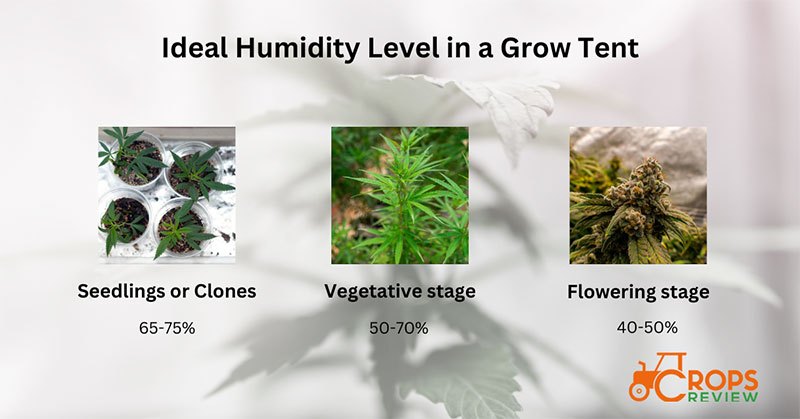
If the humidity level is too high, it leads to problems such as mold, mildew, and other fungal diseases. On the other hand, if the humidity is too low, it causes plants to lose water through transpiration faster than they absorb it, leading to wilting and stunted growth.
Why Does Humidity Control in a Grow Tent Matter?
Humidity control in a grow tent is crucial for the overall health and productivity of your plants.
Advances plant transpiration: Plants absorb water through their roots, which then travels to the leaves where it’s released as vapor into the air. This process is known as transpiration. Proper humidity levels help regulate transpiration rates. If the air is too dry (low humidity), plants lose water faster than they absorb it, leading to dehydration and stunted growth. Conversely, if the air is too humid, plants might not transpire efficiently, affecting nutrient uptake.
Prevents diseases: High humidity levels often lead to damp conditions that promote the growth of mold, mildew, and other fungal diseases. These diseases are detrimental to plant health, reducing yield quality and quantity.
Ensures optimal growth conditions: Different stages of plant growth require different humidity levels. For example, seedlings need high humidity to prevent excessive water loss, whereas, during the flowering stage, lower humidity levels are ideal to prevent bud rot and facilitate pollination.
Improves nutrient uptake: The transpiration process helps with the uptake and transport of nutrients from the soil to the plant. When the humidity level is too high or too low, this nutrient transport system can be disrupted, affecting plant health and yield.
The image below depicts the 4 main reasons why humidity control in a grow tent is important.
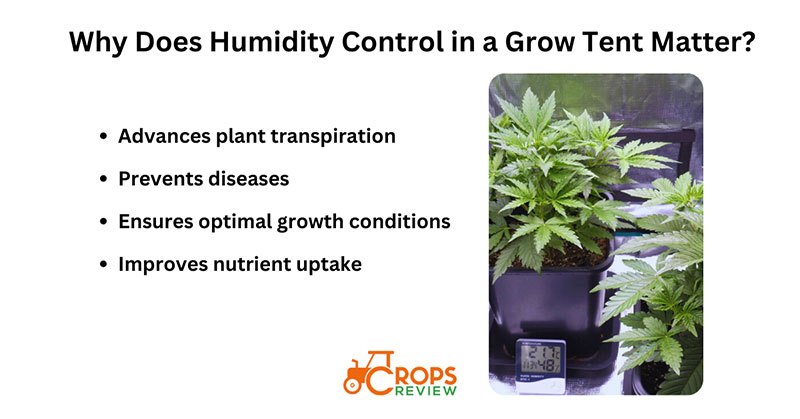
How to Measure Humidity Levels in a Grow Tent?
The most important tool for measuring humidity in your grow tent is a hygrometer. This device measures the amount of moisture in the air, providing a humidity reading as a percentage. Digital hygrometers are preferred due to their accuracy and ease of use.
Place your hygrometer at plant canopy level in your grow tent for the most accurate readings. This is because humidity levels can vary between the floor and the ceiling of the tent. By placing the hygrometer at the same height as your plants, you ensure you’re getting a reading that reflects what your plants are experiencing.
If your hygrometer shows improper humidity levels adjust them. Analog hygrometers require you to turn the knob on the hygrometer back until the gauge reads the proper humidity values. Digital hygrometers either have recalibration settings or a reset button to manually select a proper humidity range. Once you reach the proper humidity reading, you can:
- Increase humidity: Increase humidity by adding a bowl of water to your grow tent or using a humidifier. Misting your plants with water can also raise humidity levels.
- Decrease humidity: To lower humidity, increase ventilation in your grow tent. You can open vents, install an exhaust fan, or use a dehumidifier.
How to Raise the Humidity in a Grow Tent?
The image below describes 8 crucial steps to increase humidity levels in your grow tent.
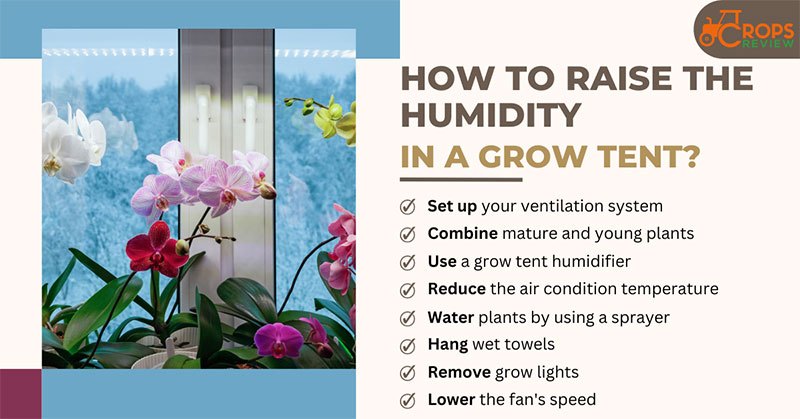
1. Set Up Your Ventilation System
Setting up a ventilation system for your indoor plant growth influences the humidity levels. Ventilation systems either increase or decrease humidity depending on how it’s used. Lower speeds increase, while more power decreases humidity.
To set up a ventilation system for a grow tent, you must:
- Gather necessary equipment (exhaust fan, intake fan, circulation fan, carbon filter, thermostat fan-speed controller)
- Choose the right size of the equipment – 4×4 grow tents require 100-300 cubic feet per minute of fans. Use two fans of different sizes – for instance, a 4″ intake fan and a 6″ exhaust fan.
- Install the exhaust fan and the carbon filter
- Install the intake fan opposite the exhaust fan
- Hang and position circulation fans
- Adjust the settings of the ventilation settings with your controller.
2. Combine Mature and Young Plants
Combining mature and young plants in a grow room, while maintaining optimal humidity levels, is a balancing act. To achieve the right humidity value, you can:
Understand the different humidity needs: Mature and young plants have different humidity requirements. Young plants or seedlings generally prefer higher humidity levels (around 70-75%) because they have a less developed root system and depend more on leaf absorption. On the other hand, mature plants require lower humidity levels (around 40-60%) to prevent fungal growth and promote transpiration, which aids nutrient uptake.
Utilize separate spaces if possible: Use separate spaces or divide your grow room for mature and young plants, each with its humidity control. Placing plants in such an order is the easiest way to cater to their different needs. Use partitions, curtains, or even separate grow tents within the same room.
Use humidity domes for seedlings: For young plants or seedlings, consider using humidity domes. These are small, clear plastic covers that retain moisture in the air around the plant. Humidity domes create a mini high-humidity environment perfect for seedlings, without affecting the rest of the grow room’s humidity.
Monitor humidity levels regularly: It’s crucial to regularly monitor the humidity levels in each area of your grow room, regardless of the setup. Use reliable hygrometers placed at the canopy level of both the mature and young plants to get accurate readings.
Adjust humidity levels as needed: If you need to increase humidity in certain areas, mist the plants lightly with water, place trays of water near the plants, or use a humidifier. If you need to decrease it, increase ventilation, use a dehumidifier, or add moisture-absorbing materials like silica gel packets.
3. Use a Grow Tent Humidifier
Using a humidifier in a grow tent is one of the most effective ways to increase humidity levels. To get the wanted level readings, use a humidifier properly.
Choose the right humidifier: Depending on the size of your grow tent, choose an appropriately sized humidifier. Larger tents require a larger or even industrial-sized humidifier. Smaller tens usually get by with a standard room humidifier.
Position the humidifier correctly: Place your humidifier in a central location inside the grow tent to distribute the moisture evenly. Avoid placing it directly under lights or near electrical equipment for safety reasons. Also, keep it away from the plants themselves to prevent over-saturation and water damage.
Set the desired humidity level: Many humidifiers come with built-in hygrometers that allow you to set a desired humidity level. If yours doesn’t have one, monitor the humidity levels manually using a separate hygrometer. Seedlings generally prefer higher humidity levels (around 70-75%) while mature plants thrive in lower humidity levels (around 40-60%).
Regularly refill the water tank: Keep an eye on the water level in your humidifier and refill it as necessary. Some humidifiers available on the market automatically shut off when the water level gets too low, but it’s best not to rely solely on this feature.
Clean the humidifier regularly: To prevent the growth of mold and bacteria, clean your humidifier regularly following the manufacturer’s instructions. Cleaning involves emptying any leftover water, wiping down the interior, and occasionally using a disinfectant or descaling agent.
Monitor and adjust as needed: Keep a close eye on your plants and the humidity levels in your tent. If your plants show signs of distress, or if the humidity level is consistently too high or too low, adjust your humidifier settings or re-evaluate your overall humidity management strategy.
4. Reduce the Air Condition Temperature
Reducing the temperature of your air conditioner raises the humidity levels in a grow room due to the relationship between temperature and air’s ability to hold moisture. When you lower the temperature in your grow room with an air conditioner, the cooler air can’t hold as much moisture as the warmer air could. So, some of the water vapor condenses into liquid water, which increases the relative humidity level in the room.
Relative humidity is defined as the amount of moisture in the air compared to the maximum amount the air could hold at that temperature. So, even if the actual amount of water vapor in the air stays the same, the relative humidity will increase if the temperature decreases.
If your humidity value reading is higher than targeted for the flowering or seedling stage, reduce the air condition temperature to 2-3 F degrees (1-2 C degrees). Monitor the levels for a day or two. If the temperature and humidity are still higher, reduce the air condition temperature again until you reach the target humidity value.
5. Water Plants by Using a Sprayer
Watering plants with a sprayer or mister helps increase and maintain humidity levels in a grow room.
When you water plants using a sprayer, you’re effectively creating tiny droplets of water that hang in the air. These droplets increase the amount of water vapor present in the atmosphere of your grow room. As the water droplets evaporate, they turn into water vapor, which increases the humidity level in the room.
Watering plants with a sprayer directly increases the humidity around the specific plants you’re watering. Watering is beneficial for plants that need higher humidity levels.
Also, avoid overwatering your plants as this leads to root rot and other diseases. Always monitor your plants and the overall humidity levels in your grow room to ensure they’re in the optimal range.
6. Hang Wet Towels
Hanging wet towels in your grow tent is a simple and cost-effective way to raise humidity levels. The principle behind this method is evaporation. To hang wet towels and raise humidity levels, you can:
Wet the towels: Soak your towels in water and wring them out so they’re damp but not dripping. The size of the towel you use will depend on how much you need to increase the humidity. Larger or multiple towels will evaporate more water, thereby increasing the humidity.
Hang the towels: Hang the towels up in your grow tent. Hang them from the ceiling, or the walls, or even place them over a rack. Make sure they are spread out and not bunched together. This maximizes the surface area exposed to the air, which increases the rate of evaporation.
Increase humidity by evaporation: As the water in the towels evaporates into the air, it increases the amount of water vapor in the air. This in turn increases the humidity level in the grow tent.
Monitor and repeat as needed: Keep an eye on the humidity levels in your grow tent using a hygrometer. Once the towels dry out, wet them again to keep the humidity levels up.
Consider mold growth when adding moisture to your grow tent, especially with organic materials like towels. Regularly clean or replace the towels to prevent mold growth.
7. Remove Grow Lights
Grow lights are a heat source, and they reduce the relative humidity in a grow tent. When you remove or turn off these lights, it leads to an increase in humidity.
When you turn off or remove the grow lights, the air temperature in the grow tent decreases. Cooler air can’t hold as much moisture, so the relative humidity – the ratio of the current amount of moisture in the air to the maximum amount it could hold at that temperature – increases.
For instance, if you have a small grow tent (2×2 feet) and you use one 600W HID light, switch to a 400W light. When you use a large (5×5 feet) or even larger grow tent, remove only one light to see whether the humidity range increases or not. If you still don’t see better results, remove two or three lights to increase humidity.
8. Lower the Fan’s Speed
Lowering the speed of a fan in a grow tent increases humidity levels. Fans aid in the process of evaporation and air circulation decreasing humidity levels.
Seedlings retain high humidity levels (70-80%), while flowering plants require lower 40-50% humidity in a grow tent. Once you read the current humidity value, start slowly and reduce the fan speed by 10-20%. Monitor the changes in humidity levels in a day or two. If the humidity range is still not the wanted one, reduce the fan’s speed further. Continue the process until you reach the target tent humidity range.
How to Lower Humidity in a Grow Tent?
The image below describes 10 methods to lower humidity in a grow tent
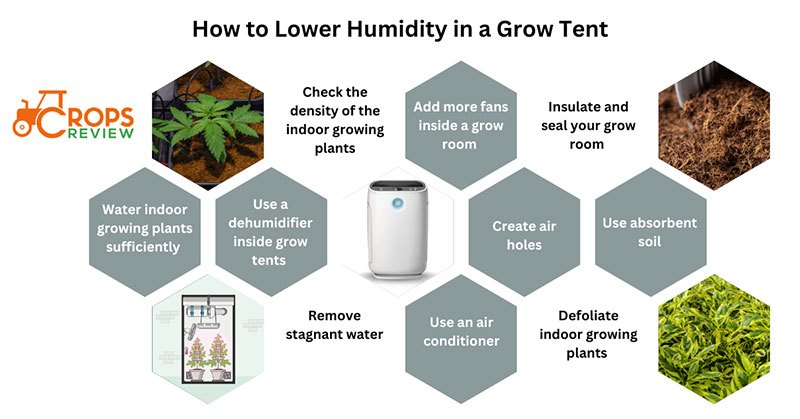
1. Water Indoor Growing Plants Sufficiently
Watering indoor growing plants is crucial to maintain healthy humidity control and prevent overwatering. Water plants with the necessary amounts of water, as overwatering slows their growth. Excess water reduces oxygen in the soil, damaging fine roots, and rendering the plant unable to take up water.
If you grow tomatoes, for instance, it’s enough to use 0.5-0.75 gallons (1.9-2.8 liters) of water per square foot per week. For peppers, 0.5 gallons (1.9 liters) of water per square foot per week is enough. Cannabis requires 0.5 to 1 gallon (1.9 to 3.8 liters) of water per day in the flowering stage for a 5-gallon pot (18.9 liters). Leafy greens such as spinach or lettuce need 1 quart (0.95 liters) per day for a large pot. Herbs, including rosemary, thyme, and basil require 2-3 days with about 1 pint (0.47 liters) to 1 quart (0.95 liters) of water each time.
2. Use a Dehumidifier Inside Grow Tents
To use a dehumidifier inside a grow tent to reduce humidity in a grow tent, first, you need to select the right dehumidifier size. For instance, smaller grow tents (2×2 feet) require a 30-pint dehumidifier, covering up to 270 square feet. On the other hand, when you have a 4×4 grow tent, use a 50-pint dehumidifier covering up to 4,500 square feet.
Next, place your dehumidifier properly – either in the center of the tent or near the intake vent. Do not block vents or disrupt airflow patterns, as blocking these channels blocks air circulation and increases the temperature.
Set your desired humidity range (between 30% and 50%). The tool runs until it achieves the target level and automatically shuts off, and turns on to maintain the set standards.
Maintain your dehumidifier regularly. Empty reservoirs to ensure dehumidifiers operate effectively. However, if a dehumidifier has a drain option, you can drain a hose outside the tent, and you don’t have to empty the reservoir manually.
Monitor both dehumdiier and hygromter readings. If you notice signs of low humidity (browsing leaf tips), adjust the settings on the dehumidifier to increase humidity and keep plants healthy.
3. Check the Density of the Indoor Growing Plants
Observe your plant spacing to ensure each plant has enough space to grow without touching neighbors. When plants are too close, they create a microclimate and increase humidity. If you use a 2×2 grow tent, you can plant between 1 to 4 plants. For bigger grow tents, for instance, 4×4, you can plant 4-16 plants. Ensure you leave at least one inch between the posts when placing the plants inside the tent. Always count your plants, and do not place more plants than the tent can accept. When there are more plants than recommended, there is not too much space for proper growth, so the humidity increases.
4. Remove Stagnant Water
Stagnant water in a grow room contributes to high humidity levels. The process of evaporation—where water turns into vapor and mixes with the air—happens not only with the water you give to your plants but also with any standing or stagnant water in the room. To prevent stagnant water:
- Always check for and promptly clean up any spills.
- Avoid overwatering your plants.
- Ensure your pots or containers have adequate drainage.
- Consider using a wet vacuum or towels to remove larger amounts of water.
- Regularly empty and clean any dehumidifiers or air conditioners, which often have a reservoir of collected water.
5. Add More Fans Inside a Grow Room
To reduce humidity in grow rooms, add more fans. Use oscillating fans near your dehumidifiers to circulate the moisture better through the growing space. Attach fans to RVK and suspend them to prevent excess moisture. Add extra fans to improve air ventilation and remove unnecessary moisture.
If you use a 2×2 grow room, one oscillating and one exhaust fan is sufficient. If you use a 4×4 grow room, use two oscillating fans and one exhaust fan.
6. Create Air Holes
By creating air holes in grow tents, you allow better air circulation and escape of excess moisture. Choose a spot on the side or top of the tent, away from the outlets to prevent damage. Use a sharp tool such as a box cutter or utility knife to cut a hole carefully. Cover the hole with a mesh screen to prevent pests from entering the grow tent. Use duct tape or glue to cover the holes.
If you have a 2×2 grow tent, make one or two air holes. If you use a 4×4 grow tent, make three or four holes for optimal ventilation and reduce moisture.
7. Use an Air Conditioner
Air conditioners work by drawing in warm, moist air from the room, cooling it down, and then releasing it back into the room as cooler, drier air. Choose a suitable conditioner for the size of your tent. A smaller, portable conditioner is great for 2×2 grow tents, while larger tools are necessary for 4×4 tents.
Place the conditioner near the intake vent to cool the incoming air. Set the temperature (ideally 70-85 F degrees/20-30 C degrees). Adjust the settings on the air conditioner to reach these target levels and monitor the settings to ensure the proper growth condition of the plants.
8. Insulate and Seal Your Grow Room
To reduce humidity in grow rooms, you can use R12 insulation for smaller 2×2 rooms. 4×4 rooms require higher insulation (R13 and more) as you have more space to cover. Install the insulation into the walls and ceiling and ensure the insulation fits all corners to prevent heat loss. Use a strong sealant to seal all the gaps in walls, floors, or ceilings. The sealant prevents pests from entering your grow rooms.
9. Use Absorbent Soil
Absorbent soil removes excess moisture from the air and reduces humidity. Look for a soil mix that has high water retention properties. This usually includes ingredients like peat moss, coconut coir, or vermiculite.
Fill your pots with the absorbent soil. Make sure not to overfill them to prevent water logging. Water your plants carefully. The absorbent soil retains more water than regular soil, so adjust your watering schedule accordingly. Use a hygrometer to monitor the humidity levels in your grow tent and adjust your watering and absorbing methods for healthy plant growth.
10. Defoliate Indoor Growing Plants
Leaves transpire water and contribute to humidity, so defoliate them to prevent moisture. Identify the leaves to remove. Remove leaves blocking light from reaching the lower parts of the plants. Remove unhealthy or diseased leaves (yellowish or brownish, attacked by mold or pests).
Use clean and sharp tools to ensure clean cuts and minimize stress on plants. Remove a few leaves at first, and monitor whether the growing conditions improve or not. If not, proceed and cut more leaves to achieve optimal plant health.
Observe humidity values after cutting. If there is not a significant change in reduced numbers, defoliate more plants. Always monitor their condition to ensure plants are responding well.
What Are the Factors That Affect Humidity in the Grow Tent?
The image below describes 6 main factors that affect the humidity in grow tents.
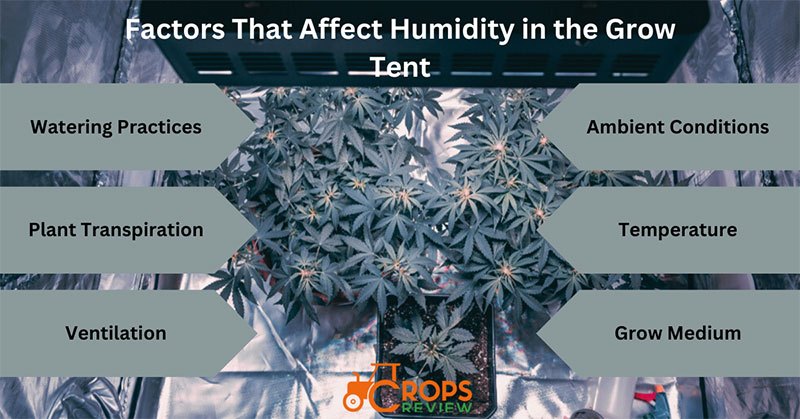
- Watering Practices: Overwatering can increase humidity as excess water evaporates from the soil into the air.
- Plant Transpiration: Plants release water vapor into the air through a process called transpiration, affecting humidity levels.
- Ventilation: Poor ventilation leads to high humidity levels as it allows moisture-laden air to remain stagnant in the grow tent.
- Ambient Conditions: The conditions outside of your grow tent, such as the weather or room environment, also impact the humidity inside the tent.
- Temperature: Warmer air can hold more moisture than cooler air, so temperature changes affect the humidity range.
- Grow Medium: Some grow mediums retain more water than others and can increase the humidity level as they release this moisture into the air.
What Are the Causes of High/Low Humidity in the Grow Tent?
The main causes of high humidity in a grow tent include: Overwatering, poor ventilation, high ambient humidity, high temperatures, or using a water-retentive grow medium cause high humidity.
The main causes of low humidity in a grow tent include: Under watering, excessive ventilation, low ambient humidity, low temperatures, or using a non-absorbent grow medium leads to low humidity.
What Are the Effects of High/Low Humidity in the Grow Tent?
If the humidity is too high, mold and mildew grow, which damages plants and poses health risks. High humidity also causes plant diseases and encourages pest infestations. It also hinders plant transpiration, impacting nutrient uptake and overall plant health.
If the humidity is too low, it causes plants to lose water too quickly through transpiration, leading to dehydration and stress. Low humidity results in symptoms like wilting, yellowing leaves, slowed growth, and reduced yield.
Does Temperature Affect The Ideal Humidity Range?
Yes, the temperature does affect the ideal humidity range. Warm air holds more moisture than cool air. As a result, the relative humidity (the amount of moisture the air is holding relative to the maximum amount it can hold) changes with fluctuations in temperature.
As the temperature increases, the air carries more humidity. Conversely, when the temperature decreases, the air holds less moisture, leading to a higher humidity level even if the actual amount of moisture in the air remains the same.
This relationship between temperature and humidity also explains why indoor humidity levels may vary with the seasons. More excess moisture indoors appears during colder weather. The ideal range of comfortable temperatures for home humidity levels is in the 40 to 60% range, depending on the season, according to the American Society of Heating, Refrigerating, and Air-Conditioning Engineers.
Another tool to control temperature and humidity in grow tents is the VDP. Vapor Pressure Deficit (VPD) measures the difference between the amount of moisture in the air and how much moisture the air can hold when it is saturated. It is usually measured in kiloPascals (kPa). VPD gives growers an idea of the evapotranspiration potential, meaning how much water your plants will likely lose to the atmosphere under current conditions.
The optimal range of the VDP is 0.8 to 1.2 kPa during the vegetative stage and 1.2 to 1.5 kPa during the flowering stage. VPD is the “thirst” of the air. The higher the VPD, the thirstier the air is, pulling more water from your plants through transpiration.
Low VPD (high humidity) means the air is nearly saturated with water vapor, and it’s difficult for the plant to transpire effectively. This leads to slower growth rates and increased risk of mold or fungal diseases. High VPD (low humidity) means the air is dry, and plants transpire too quickly, leading to wilting or nutrient burn.
VPD is also affected by temperature because warmer air holds more moisture than cooler air. If the temperature in your grow tent increases, the capacity of the air to hold water vapor also increases, raising the VPD. High temperatures and low humidity lead to dangerously high VPD levels, causing plant stress.
What Are the Ideal Temperature and Humidity Levels for Growing Room Plants?
The image below depicts the ideal temperature and humidity for 5 popular houseplants, including Cactus, Snake Plant, Spider Plant, Aloe Vera, and Jade Plant.
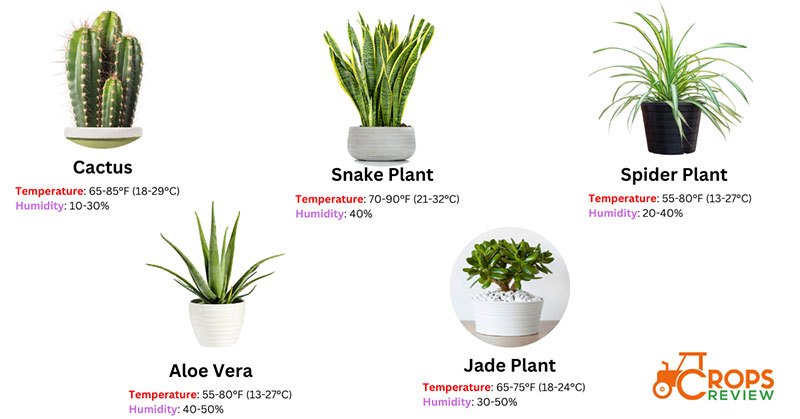
Cactus (Cactaceae family): Cacti prefer temperatures between 65-85°F (18-29°C) during the day and a slight drop at night. They thrive in low-humidity environments, usually between 10-30%.
Snake Plant (Sansevieria trifasciata): Snake plants prefer temperatures between 70-90°F (21-32°C). They handle humidity levels as low as 40%, but they’re quite adaptable and tolerate higher humidity as well.
Spider Plant (Chlorophytum comosum): Spider plants prefer temperatures between 55-80°F (13-27°C) and tolerate humidity levels as low as 20-40%.
Aloe Vera (Aloe barbadensis miller): Aloe vera prefers temperatures between 55-80°F (13-27°C). It’s a desert plant, so it thrives in low-humidity environments, usually between 40-50%.
Jade Plant (Crassula ovata): Jade plants prefer temperatures between 65-75°F (18-24°C) and handle low humidity levels of around 30-50%.
